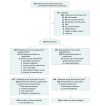Effect of Targeted Polymyxin B Hemoperfusion on 28-Day Mortality in Patients With Septic Shock and Elevated Endotoxin Level: The EUPHRATES Randomized Clinical Trial
- PMID: 30304428
- PMCID: PMC6233793
- DOI: 10.1001/jama.2018.14618
Effect of Targeted Polymyxin B Hemoperfusion on 28-Day Mortality in Patients With Septic Shock and Elevated Endotoxin Level: The EUPHRATES Randomized Clinical Trial
Abstract
Importance: Polymyxin B hemoperfusion reduces blood endotoxin levels in sepsis. Endotoxin activity can be measured in blood with a rapid assay. Treating patients with septic shock and elevated endotoxin activity using polymyxin B hemoperfusion may improve clinical outcomes.
Objective: To test whether adding polymyxin B hemoperfusion to conventional medical therapy improves survival compared with conventional therapy alone among patients with septic shock and high endotoxin activity.
Design, setting, and participants: Multicenter, randomized clinical trial involving 450 adult critically ill patients with septic shock and an endotoxin activity assay level of 0.60 or higher enrolled between September 2010 and June 2016 at 55 tertiary hospitals in North America. Last follow-up was June 2017.
Interventions: Two polymyxin B hemoperfusion treatments (90-120 minutes) plus standard therapy completed within 24 hours of enrollment (n = 224 patients) or sham hemoperfusion plus standard therapy (n = 226 patients).
Main outcomes and measures: The primary outcome was mortality at 28 days among all patients randomized (all participants) and among patients randomized with a multiple organ dysfunction score (MODS) of more than 9.
Results: Among 450 eligible enrolled patients (mean age, 59.8 years; 177 [39.3%] women; mean APACHE II score 29.4 [range, 0-71 with higher scores indicating greater severity), 449 (99.8%) completed the study. Polymyxin B hemoperfusion was not associated with a significant difference in mortality at 28 days among all participants (treatment group, 84 of 223 [37.7%] vs sham group 78 of 226 [34.5%]; risk difference [RD], 3.2%; 95% CI, -5.7% to 12.0%; relative risk [RR], 1.09; 95% CI, 0.85-1.39; P = .49) or in the population with a MODS of more than 9 (treatment group, 65 of 146 [44.5%] vs sham, 65 of 148 [43.9%]; RD, 0.6%; 95% CI, -10.8% to 11.9%; RR, 1.01; 95% CI, 0.78-1.31; P = .92). Overall, 264 serious adverse events were reported (65.1% treatment group vs 57.3% sham group). The most frequent serious adverse events were worsening of sepsis (10.8% treatment group vs 9.1% sham group) and worsening of septic shock (6.6% treatment group vs 7.7% sham group).
Conclusions and relevance: Among patients with septic shock and high endotoxin activity, polymyxin B hemoperfusion treatment plus conventional medical therapy compared with sham treatment plus conventional medical therapy did not reduce mortality at 28 days.
Trial registration: ClinicalTrials.gov Identifier: NCT01046669.
Conflict of interest statement
Figures

Comment in
-
Haemoperfusion with polymyxin B membrane: Recent results for an old debate!Anaesth Crit Care Pain Med. 2019 Feb;38(1):3-4. doi: 10.1016/j.accpm.2018.12.010. Epub 2019 Jan 8. Anaesth Crit Care Pain Med. 2019. PMID: 30635098 No abstract available.
-
The Role of Endotoxin in Septic Shock.JAMA. 2019 Mar 5;321(9):902-903. doi: 10.1001/jama.2018.20874. JAMA. 2019. PMID: 30835303 No abstract available.
References
-
- Klein DJ, Derzko A, Foster D, et al. . Daily variation in endotoxin levels is associated with increased organ failure in critically ill patients. Shock. 2007;28(5):524-529. - PubMed
-
- Dellinger RP, Tomayko JF, Angus DC, et al. ; Lipid Infusion and Patient Outcomes in Sepsis (LIPOS) Investigators . Efficacy and safety of a phospholipid emulsion (GR270773) in gram-negative severe sepsis: results of a phase II multicenter, randomized, placebo-controlled, dose-finding clinical trial. Crit Care Med. 2009;37(11):2929-2938. doi:10.1097/CCM.0b013e3181b0266c - DOI - PubMed
Publication types
MeSH terms
Substances
Associated data
LinkOut - more resources
Full Text Sources
Other Literature Sources
Medical
Miscellaneous

